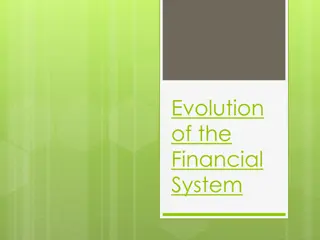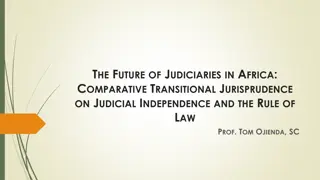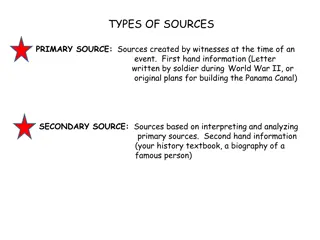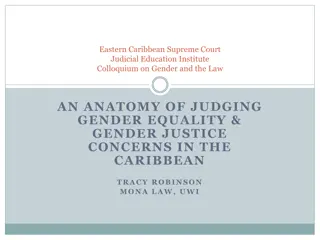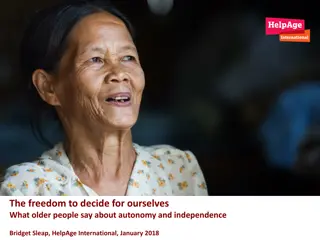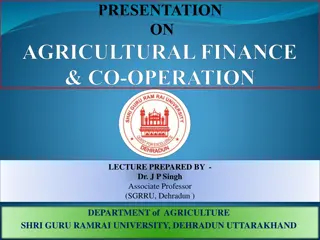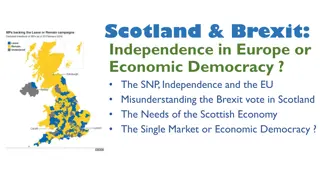The Declaration of Independence and its Impact on the American Revolution
The American colonies' journey to independence during 1775-1776 is highlighted, from initial hopes for reconciliation to the eventual Declaration of Independence. The document's significance is explored, focusing on the response it garnered, the process leading to its approval, and the outlined righ
3 views • 15 slides
Ireland's Engagement with the League of Nations: Path to Independence
Ireland's entry into the League of Nations in 1923 marked a significant step towards independence after the War of Independence and Civil War. Through joining the League and asserting its independence, Ireland demonstrated its readiness to participate in global initiatives for peace and cooperation.
5 views • 17 slides
Establishing Safety Standards in Non-Movement Areas at Smith Reynolds Airport
This guide outlines the purpose, definitions, rules, and safety measures for operating vehicles in non-movement areas at Smith Reynolds Airport. It emphasizes standardized ground movement practices to ensure the safety of airport patrons, reduce the risk of injury, and maintain a high level of safet
2 views • 12 slides
Family Assets for Independence in Minnesota (FAIM) Program Overview
The Family Assets for Independence in Minnesota (FAIM) program helps individuals achieve financial independence through a structured process involving eligibility criteria, opening a savings account, financial coaching, obtaining assets, and closing the account. Eligibility requirements include inco
0 views • 25 slides
Evolution of the Indian Financial System: A Historical Perspective
The Indian Financial System has evolved through distinct phases - Pre-Independence, Post-Independence up to 1991, and post-1991. Pre-Independence saw a closed economy with limited access to foreign savings. Post-Independence witnessed significant growth, nationalization of banks and insurance, devel
0 views • 20 slides
Conditional Probability and Independence in Statistics
Conditional probability and independence are essential concepts in statistics. This lesson covers how to find and interpret conditional probabilities using two-way tables, calculate probabilities using the conditional probability formula, and determine the independence of events. Through examples li
2 views • 15 slides
The Future of Judiciaries in Africa: Comparative Transitional Jurisprudence
Judicial independence in Africa is crucial for upholding the rule of law and fostering economic growth. This article explores the key aspects of judicial independence, the challenges faced in implementing it, and the impact on governance and human rights. Countries in transition, such as Kenya, are
0 views • 25 slides
Ensuring Judicial Independence and Accountability: Model Code of Judicial Conduct
An overview of the history and significance of the Model Code of Judicial Conduct, focusing on judicial independence, integrity, and accountability. The discussion highlights the crucial role of an impartial judiciary in upholding the rule of law and the efforts made to update and maintain ethical s
0 views • 16 slides
Overview of Quit India Movement and its Phases
The Quit India Movement was a significant event in India's struggle for independence, marked by various factors leading to its emergence, including the demise of the Civil Disobedience Movement and the rise of nationalist sentiments. The movement escalated in response to the outbreak of World War II
1 views • 9 slides
Te Ata T. Training for Independence Contract - Service Details
Te Ata T. Training for Independence Contract is designed to restore and maintain the independence of clients with functional impairments, excluding severe cases. The service aims to reduce the need for further rehabilitation by providing tailored assistance to individuals meeting specific criteria.
0 views • 10 slides
Best Practices for Independence in Implementing FASB ASC 606
Independence considerations are crucial when assisting attest clients with FASB ASC 606 implementation. General requirements and dos and don'ts must be followed to maintain independence. Factors to assess independence include client responsibility, training provided, and extent of involvement. Audit
0 views • 6 slides
Planning for Independence Program (PIP) - Empowering Students for Success
Our Planning for Independence Program (PIP) offers a 7-year alternative program to students with Intellectual Developmental Exceptionality. Through individualized education programs, students develop necessary skills for independence, including transit training, social skills, literacy, and numeracy
0 views • 9 slides
Celebrating Independence Day in Bangladesh: A Joyous National Festival
26th March marks Bangladesh's Independence Day, a significant state festival celebrated with great enthusiasm and fervor throughout the country. The day includes various ceremonies, tributes to martyrs, cultural programs, parades, and sports events, showcasing the heroic struggle and sacrifice of 19
0 views • 31 slides
The Convention of 1836 and the Texas Declaration of Independence
The Convention of 1836 held in Washington on the Brazos led to the drafting of the Texas Declaration of Independence, declaring Texas as a free and sovereign republic. The declaration highlighted grievances against Mexico and the adoption of a new constitution on March 2, 1836, known as Texas Indepe
0 views • 12 slides
John H. Chafee Foster Care Independence Program (CFCIP) Overview
The John H. Chafee Foster Care Independence Program (CFCIP) is a federal initiative established under the Foster Care Independence Act of 1999 to support youth transitioning out of foster care. It provides various services such as job training, housing assistance, education support, and financial ai
0 views • 10 slides
The Quit India Movement 1942-1945: An August Movement
The Quit India Movement, also known as the August Movement or Do or Die Movement, was a mass protest on nonviolent lines in India from 1942 to 1945. Initiated by the Indian National Congress, it called for an immediate end to British rule in India. Led by leaders like Mahatma Gandhi, the movement ai
0 views • 16 slides
The Quit India Movement: A Pivotal Moment in India's Independence Struggle
The Quit India Movement, also known as the India August Movement, was a key event in India's fight for independence led by Mahatma Gandhi in 1942. This movement urged the British to grant India independence through peaceful non-violent protests. It called for an immediate end to British rule, the fo
0 views • 15 slides
Overview of Quit India Movement in Indian History
The Quit India Movement, initiated by Mahatma Gandhi in 1942, aimed to end British rule in India. It was a response to the collapse of the Cripps Mission and demanded immediate independence, leading to a series of strikes and demonstrations. The movement had three key phases, with significant contri
0 views • 16 slides
The Declaration of Independence: An Insightful Overview
Learn fascinating facts about the Declaration of Independence, including the actual signing date, the key drafters, and the influence of John Locke's Enlightenment ideas. Explore the three parts of the declaration and understand its significance in declaring independence from England.
1 views • 4 slides
Important Milestones in American History and Sources of Information
This content provides a comprehensive overview of different types of historical sources, crucial dates in American history, significant time periods post-Civil War, and key historical documents like the Declaration of Independence. It distinguishes between primary and secondary sources, lists import
0 views • 11 slides
Journey to Independence: The Road to the Declaration
Explore the pivotal events leading to the Declaration of Independence in 1776, including failed petitions, early declarations, and the drafting process. Learn about the reasons behind declaring independence and the key figures involved in shaping this historic document.
0 views • 18 slides
Declaration of Independence Scavenger Hunt and Discussion
Explore clues and discussions surrounding the Declaration of Independence in this engaging scavenger hunt. Discover insights into the authors' identities, the document's intended audience, grievances, and evidence supporting independence. Delve into a thought-provoking discussion on the justificatio
0 views • 8 slides
The American Revolution: Pursuit of Independence
The American Revolutionary War of 1776-1783 marked a significant turning point in history as colonists sought independence from British rule. The support for independence was fueled by figures like Thomas Paine and pivotal documents such as the Declaration of Independence. The divide among colonists
0 views • 20 slides
The Path to American Independence: Lessons from History
Explore pivotal moments in American history from the Continental Congress forming the Continental Army to the drafting and approval of the Declaration of Independence. Learn about key figures like George Washington, Thomas Paine, and Thomas Jefferson who played crucial roles in shaping the course of
0 views • 13 slides
Causes and Reactions of the American War of Independence
The American War of Independence was fueled by various causes, including taxation without representation, economic restrictions on trade imposed by Britain, and defiance through protests like the Boston Tea Party. The colonies fought for their independence, culminating in the Declaration of Independ
0 views • 4 slides
Vocabulary from the Declaration of Independence
Vocabulary from the Declaration of Independence includes terms such as impel, prudence, despotism, usurpations, tyranny, candid, relinquish, annihilation, appropriation, and abdicate. These terms are used to describe the actions and characteristics of governments and rulers, as outlined in the Decla
0 views • 16 slides
Roles of South Carolinians in the Adoption of the Declaration of Independence
South Carolinians played crucial roles in the adoption of the Declaration of Independence during the American Revolution. Delegates from South Carolina participated in the Second Continental Congress where the Declaration was debated and signed, affirming the United States' intent to break away from
0 views • 7 slides
Mexican War of Independence (1810-1821): A Historical Journey
The Mexican War of Independence (1810-1821) was a tumultuous period marked by leaders like Miguel Hidalgo and Jose Morelos who fought against Spanish rule in Mexico. Despite setbacks, the struggle for independence persisted, eventually culminating in the declaration of Mexico's independence and the
0 views • 10 slides
The Path to American Independence: Constitution, Revolution, and Ideals
Explore the historical journey of America's independence, from the origins of the constitution and the road to revolution, to declaring independence and the influence of English heritage on American ideals. Discover the key roles of figures like John Locke and Thomas Jefferson, and how the American
0 views • 29 slides
Understand Paragraph Writing: War of Independence Lesson
Learn about writing paragraphs through the lens of the War of Independence. Discover the structure of a paragraph, its components, and delve into the historical context of Bangladesh's struggle for independence. Enhance your writing skills and grasp the significance of organizing thoughts effectivel
0 views • 21 slides
Palestinian National Institute of Public Health Legal Model 2016 Review
The legal model of the Palestinian National Institute of Public Health in 2016 aimed at establishing a clear legal status to enforce the independence of public health institutes. Key aspects included the development and approval of PNIPH's law, a code of conduct ensuring law enforcement, financial i
0 views • 6 slides
Gender Equality and Judicial Independence in the Caribbean
This content explores the role of judges in promoting gender equality and justice in the Caribbean region, discussing preliminary points, judicial independence, and the rule of law. It emphasizes the importance of judges maintaining professional competence and independence to address gender equality
0 views • 30 slides
Independence in Probability: A Comprehensive Overview
Explore the concepts of independence and conditional independence in probability, with examples like coin tosses, dice rolls, and real-world scenarios. Learn how knowing the value of one variable affects the probability distribution of another, and how to calculate probabilities under independence a
0 views • 56 slides
Perspectives on Autonomy and Independence in Older Age
Understanding the perspectives on autonomy and independence in older age, as shared by individuals from 24 countries through a consultation conducted by various organizations. Older people express the importance of making their own decisions, the impact of health on independence, challenges in maint
0 views • 13 slides
Evolution of Indian Cooperative Movement: Pre and Post Independence Phases
Explore the historical journey of the Indian cooperative movement from its inception pre-independence to its development post-independence. Learn about the origin, phases, challenges, reforms, and progress through various five-year plans, highlighting key aspects and recommendations made by committe
0 views • 5 slides
History of Conflict and Independence in Ukraine
The history of Ukraine is marked by conflicts, independence struggles, and political upheavals. From the establishment of the Central Rada in 1917 to the Orange Revolution in 2004, the country has seen shifts in power, annexations, declarations of independence, and resistance to Soviet rule. The jou
0 views • 19 slides
Scotland's Brexit Dilemma: Independence, EU, and Economic Challenges
Scotland faces a complex decision regarding Brexit, with debates on independence, EU membership, and economic concerns. The SNP's stance, Scottish economy analysis, and the rise in independence support are key points in this ongoing discussion.
0 views • 16 slides
Mahatma Gandhi and the Indian Freedom Movement
Mohandas Karamchand Gandhi, also known as Mahatma Gandhi, played a pivotal role in India's freedom movement with his philosophy of nonviolence and civil disobedience. Born in 1869 in Porbandar, Gujarat, Gandhi's experiences in South Africa and return to India in 1915 shaped his activism. He led move
0 views • 11 slides
Pathways to Independence: Empowering Young Women for a Brighter Future
Pathways to Independence is dedicated to transforming the lives of young women in Long Beach and Orange County who have faced abuse and neglect by providing them with resources for education, healing, and support. Through programs that emphasize community impact, efficiency, financial stability, and
0 views • 19 slides
Irish Economic History to Independence: Overview and Perspectives
Explore the economic history of Ireland leading up to independence, including key events, policies, and perspectives on economic performance. Topics cover trade policy, fiscal and monetary policy at independence, readings, and the structure of economic history since independence.
0 views • 25 slides




